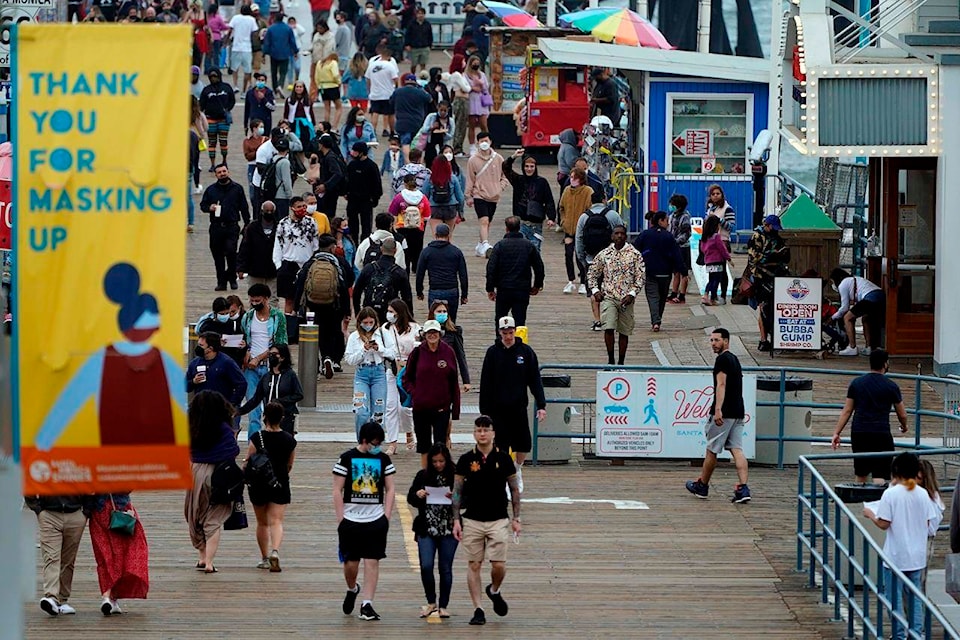California no longer will require social distancing and will allow full capacity for businesses when the state reopens on June 15, the state’s top health official said Friday.
“We’re at a place with this pandemic where those requirements of the past are no longer needed for the foreseeable future,” Secretary of California Health and Human Services Dr. Mark Ghaly said.
He said dramatically lower virus cases and increasing vaccinations mean it’s safe for California to remove nearly all restrictions next month. The state of nearly 40 million people has administered nearly 35.5 million vaccine doses, he said, and more than three-quarters of residents over 65 have received at least one dose.
As one result, the state in mid-June will end its color-coded four-tier system that restricts activities based on each county’s virus prevalence.
Limits on how many people can be inside businesses at any one time will disappear, he said, and “there will no longer be (physical distancing) restrictions for attendees, customers and guests in business sectors.”
That won’t mean an abrupt end to wearing masks, he said, but the state will adjust its guidelines to correspond to national guidelines.
Officials already announced this week that they would wait until mid-June to follow the U.S. Centers for Disease Control and Prevention’s new mask guidelines that say it’s safe for fully vaccinated people to skip face coverings and social distancing in virtually all situations. The federal guidelines state that everyone should still wear masks in crowded indoor locations such as airplanes, buses, hospitals and prisons.
California’s workforce regulators are separately developing safety rules that will continue to apply to employers, Ghaly said.
“I can’t emphasize enough how the vaccine has allowed us to get to a place where we can safely do the things that we loved to do before the pandemic,” said Los Angeles County health director Barbara Ferrer. The state’s lingering deaths, she said, “are almost all among people not fully vaccinated. This is preventable.”
The state will still require vaccine verification or negative test results within 72 hours for indoor events with more than 5,000 attendees.
State officials will also recommend that organizers of outdoor events with more than 10,000 people require attendees to provide verification that they have been vaccinated or have tested negative for the coronavirus. Those who can’t or don’t provide the verification should be encouraged by organizers to wear masks, Ghaly said.
“I’m very confident in their decisions and very confident this is the right move,” said Dr. Monica Gandhi, an infectious disease expert at the University of California, San Francisco.
Gandhi said there is plenty of evidence that vaccines are effective and California has done a good job of distributing doses.
State officials do not anticipate that they will create or require a vaccination “passport” or other formal verification, Ghaly said.
The more than three weeks of lead time before the changes go into effect “will provide ample time for our businesses, organizations and residents to prepare for these changes,” Los Angeles County Supervisor Kathryn Barger said.
California also plans to follow federal CDC guidelines on travel, meaning it will not be discouraged except in places where visiting is not advised.
“We have weathered the storm, and I am hopeful that this finally signals our return to normalcy,” Barger said.
California was the first state to issue a statewide shutdown as the virus emerged in March 2020 and it was the nation’s epicenter for the disease at the start of 2021. More than 61,000 people have died from the virus in California, the most in any state in the nation.
Gov. Gavin Newsom, a Democrat, has said for weeks that the state expected to generally lift most business and social restrictions by June 15.
“I think our shared objective has always been to get the economy open as quickly as we can by safely doing so,” said Dee Dee Myers, director of the Governor’s Office of Business and Economic Development. Newsom faces a recall election this fall driven in large part by those frustrated with his restrictions during the pandemic.
“Restrictions around eating and drinking, open bars, buffets, things like that will all go away,” she said. People can now also plan with certainty for weddings, conventions and large sporting events, “a really important milestone” as officials try to reinvigorate the economy.
In recent days, newly reported infections in California have fallen below 1,000 and there are currently just over 1,300 people hospitalized with the virus. The state’s current positivity rate is just 1%.
Lifting restrictions will inevitably result in some increased transmissions, but the health care system should be able to handle them and local officials can still impose additional limits if there are outbreaks, Ghaly said. Health officials will continue tracking whether virus mutations start breaking through vaccinations, which he said could mean renewed health measures.
“We’re going to be watching that very closely,” he said. “But I think we are in a place statewide where we have a significant number of people vaccinated and protected.″
Like us on Facebook and follow us on Twitter.
Want to support local journalism? Make a donation here.
